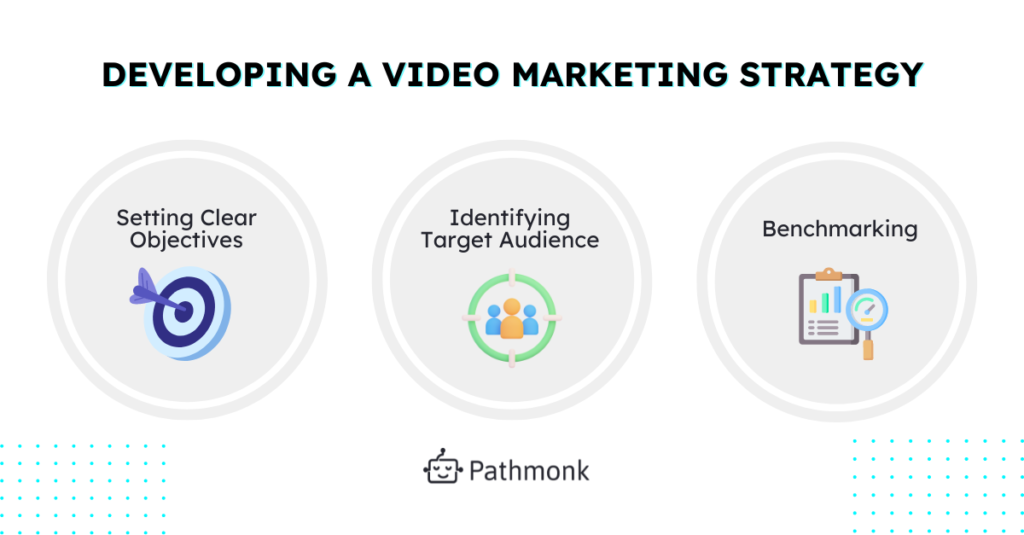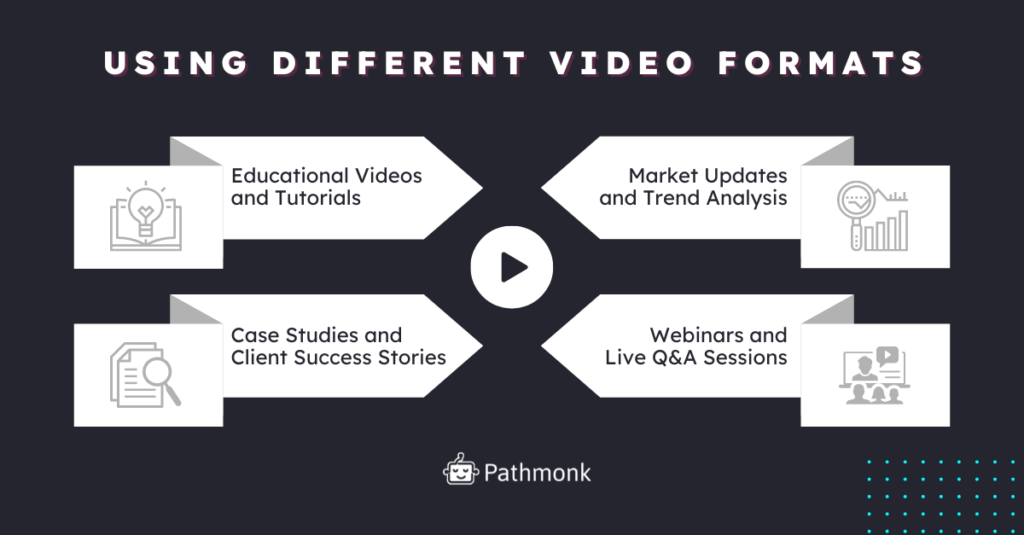
Let’s face it—finance isn’t exactly the most thrilling topic for most people. But who said we can’t make it engaging? If you’re still relying solely on whitepapers and blog posts to reach your audience, you might be stuck in the Stone Age. With the meteoric rise of video content, it’s about time we leverage this dynamic medium to not only attract but also retain clients in the finance industry.
According to a report by Wyzowl, 86% of businesses now use video as a marketing tool, up from 63% in 2017. The finance industry is no exception. Video marketing offers a unique opportunity to simplify complex topics, build trust, and establish authority. So, let’s break down how you can get more clients using video content marketing and Pathmonk, increasing your website conversion rate by 50% on average and personalizing customer experience.
Table of Contents
Challenges of Video Content Marketing in the Finance Industry
Regulatory and Compliance Considerations
One of the first hurdles we face is regulatory compliance. Unlike other industries, finance is heavily regulated. Every piece of content must adhere to guidelines set by regulatory bodies like the SEC or FCA. This means your videos need to be both informative and compliant, a tricky balance to strike. A misstep can result in hefty fines or legal repercussions.
To navigate these waters, always consult with your compliance team during the planning stages. Scripts should be reviewed and approved before production, ensuring all necessary disclaimers and disclosures are included. Use tools like Red Oak Compliance to streamline this process and ensure that your content stays within regulatory boundaries.
Building Trust and Credibility
Trust is the currency in the finance world. Clients need to know their money is in safe hands. Video content allows you to humanize your brand, showing real people behind the numbers. Authenticity is key here. A well-produced video featuring your team members can build a connection that text simply can’t achieve.
Managing Complex Topics
Finance can be mind-numbingly complex. Try explaining derivatives or tax optimization strategies in a blog post without losing your audience. Video, however, allows us to break down these topics visually. Use animations, infographics, and real-world examples to make the content digestible and engaging.
Overcoming Audience Skepticism
One of the significant challenges in the finance industry is overcoming audience skepticism. Financial services have a reputation for being complicated, and many people approach them with caution. This inherent distrust can make it difficult to engage potential clients through video content.
Viewers might be wary of the information provided, questioning its accuracy or the motives behind it. This skepticism can be a barrier to building initial engagement and trust, which are crucial for converting viewers into clients.
High Production Costs and Resource Allocation
Creating high-quality video content is not cheap, and the finance industry often requires a higher production standard due to the nature of the information being shared. From scripting and filming to editing and compliance reviews, each stage demands considerable resources, both financial and human.
Developing a Video Content Marketing Strategy in Finance
Let’s dive into the crucial steps necessary to create a robust video content marketing strategy for the finance industry.
Setting Clear Objectives
Before hitting the record button, you need to set clear objectives. Are you looking to increase brand awareness, generate leads, or perhaps educate your existing clients? Defining goals will guide your content creation and ensure your videos are aligned with your overall marketing strategy.
- For brand awareness, focus on videos that highlight your company’s values, mission, and unique selling points.
- For lead generation, create content that addresses common pain points and offers solutions, incorporating strong calls-to-action.
- Educational videos should be aimed at nurturing existing clients, providing them with valuable insights and updates.
Identifying the Target Audience
Knowing your audience is crucial. Are you targeting young professionals just starting their investment journey, or seasoned investors looking for advanced strategies? Tailoring your content to meet the specific needs and preferences of your audience will make your videos more relevant and effective.
Use analytics tools like Pathmonk and social media insights to gather data on your audience’s demographics, interests, and behavior. This information can help you create detailed buyer personas, guiding your content creation to ensure it resonates with your target market.
Competitive Analysis and Benchmarking
Take a look at what your competitors are doing. Analyze their video content—what’s working and what isn’t? Use this information to differentiate your own content. Benchmarking against industry standards can also provide insights into how you can improve and innovate.
Tools like SEMrush and Ahrefs can help you conduct a competitive analysis, identifying the keywords and topics your competitors are focusing on. Use this data to find gaps in the market and create content that addresses unmet needs or offers a unique perspective.

Using Different Video Formats on Your Strategy
Here are different video formats you can leverage to engage and educate your audience in the finance industry.
Educational Videos and Tutorials
Educational videos are a fantastic way to provide value. Create tutorials that explain fundamental concepts like “What is a mutual fund?” or “How to start investing in stocks.” These videos can position you as a thought leader and build trust with potential clients.
When creating educational content, break down complex topics into smaller, easily digestible segments. Use visuals, such as charts and graphs, to support your explanations. Additionally, ensure your videos are accessible, with clear audio and subtitles to accommodate different viewing preferences.
Some specific tools can help create animated videos that simplify complex financial concepts. They usually offer templates and customization options that make it easier to produce professional-quality videos that resonate with your audience.
Case Studies and Client Success Stories
Nothing speaks louder than success. Use case studies and client testimonials to showcase how your services have made a difference. Real-world examples can illustrate the benefits of your offerings and persuade prospects to become clients.
Create detailed case study videos that walk through the challenges a client faced, the solutions you provided, and the results achieved. Use metrics and data to substantiate your claims, and include quotes from satisfied clients to add authenticity and credibility.
Seeing real clients talk about their positive experiences can significantly boost credibility. Additionally, leverage the power of behind-the-scenes videos to showcase your team’s expertise and dedication. This transparency fosters trust and helps potential clients feel more comfortable engaging with your brand.
Market Updates and Trend Analysis
Stay relevant by providing regular market updates and trend analyses. This not only keeps your audience informed but also positions you as an expert who is on top of current events. Timely content can drive engagement and foster a loyal following.
Consider producing a weekly or monthly market update series, discussing recent developments and their potential impact on your audience. Use platforms like LinkedIn Live or YouTube Live for real-time interaction, allowing viewers to ask questions and engage with your content directly.
Webinars and Live Q&A Sessions
Interactive formats like webinars and live Q&A sessions allow for real-time engagement. These sessions can be used to address client concerns, provide expert insights, and foster a sense of community. Plus, they offer a platform for direct interaction with your audience, making your brand more approachable.
Promote your webinars and Q&A sessions through multiple channels, including email newsletters, social media, and your website. Ensure you have a well-prepared agenda and engaging presenters who can effectively communicate and answer questions on the spot.
Small to mid-sized firms may find it particularly challenging to allocate the necessary budget and personnel for consistent video production. Webinars and live sessions may be a good way to overcome this issue, as it usually doesn’t require more than 1 or 2 people to make it happen. You can also find many webinar software solutions at a reasonable cost.

How to Enhance Engagement and Interaction
Now that you have put your video content marketing strategy in place, it’s time to focus on how to get more views and generate engagement. Here are some strategies you could use:
Interactive Video Features
Interactive videos can significantly boost engagement. Incorporate features like polls, clickable links, and quizzes to make your content more engaging. These elements can also provide valuable insights into your audience’s preferences and behaviors.
Platforms like Wistia and Vidyard offer interactive video capabilities, allowing you to embed quizzes, surveys, and CTAs directly into your videos. Use these features to gather feedback, drive conversions, and keep viewers engaged throughout the video.
Personalization and Segmentation
Use data to segment your audience and deliver personalized video content that meets their specific needs. Personalized videos can increase engagement and drive conversions by making your audience feel valued and understood.
Tools like Pathmonk automatically segment your audience based on their behavior, preferences, demographics and, most importantly, stage on the buying journey. This data can be used to create tailored video content that addresses specific pain points or interests, enhancing the relevance and impact of your marketing efforts.
Using CTAs Effectively
A well-crafted call-to-action (CTA) can be the difference between a passive viewer and an active client. Use clear and compelling CTAs in your videos to guide your audience toward the next step, whether it’s signing up for a newsletter, downloading a whitepaper, or scheduling a consultation.
Place your CTAs strategically throughout the video, not just at the end. Use compelling language that creates a sense of urgency and highlights the benefits of taking action. Test different CTAs to see which ones resonate most with your audience.
Measuring Performance
Performance tracking is the only way to know if your video content strategy is working and/or needs to be enhanced. Tracking the right metrics is essential to understanding the effectiveness of your video content. Key metrics include view count, engagement rate, and conversion rate. These metrics can provide insights into how well your videos are performing and where there might be room for improvement.
Other important KPIs to consider are watch time, click-through rates (CTR), and the number of shares or comments. These metrics can help you gauge the level of interest and interaction your videos are generating, providing a more comprehensive view of their impact.
Integrate analytics tools with your CRM and marketing automation platforms to gain deeper insights into how video content influences the customer journey. This integration allows you to track video interactions and link them to specific leads or sales, providing a clearer picture of your video’s effectiveness.
A/B Testing and Continuous Improvement
A/B testing is a powerful method to determine what works best for your audience. Test different video lengths, formats, and CTAs to see what resonates most. Continuous improvement through iterative testing and feedback is key to staying ahead in the ever-evolving landscape of video content marketing.
Set up controlled experiments where you change one variable at a time, such as the video thumbnail or the opening hook. Analyze the results to understand which variations perform better and implement the findings to optimize future content.
Pathmonk: AI-Powered Personalization for High-Converting Websites
In the financial industry, building trust and transmitting authority is one of the most important things for acquiring new and faithful clients. But just creating video content randomly will not help you achieve your goal if this content is not appearing to the right audience, at the time they need it the most.
With Pathmonk, you can transform your website from a simple source of information in finances to a complete high-converting user experience – and expect a 50% growth in conversion on average 😉 By applying advanced AI for data analytics, our solution tailors the user journey in real-time, ensuring that each visitor sees the content most likely to convert them. Your content marketing strategy can have a real impact on your visitor’s experience, ensuring the efficiency of your video marketing efforts.
Test out Pathmonk with this personalized interactive demo, or book a product tour with one of our specialists!
Increase +180%
leads
demos
sales
bookings
from your website with AI
Get more conversions from your existing website traffic delivering personalized experiences.

Finally, if you haven’t already, it’s time to pick up that camera and start creating. Remember, the finance industry may be complex, but your marketing doesn’t have to be boring. Happy filming!





